THURSDAY
JANUARY 15 - 2015
Brook
Meadow
After the
storms and heavy rainfall overnight, I donned my
wellies for this morning's work session on Brook
Meadow. The meadow was very wet and full of puddles,
but the morning was fine and the workday went ahead as
scheduled. Jennifer Rye outlined the main jobs for the
day, which included spreading the pile of wood
chippings from the tree felling over the muddy paths.
This will not be welcomed by the Siberian Chiffchaff
which appears to favour the wood chips pile as a
source of food.
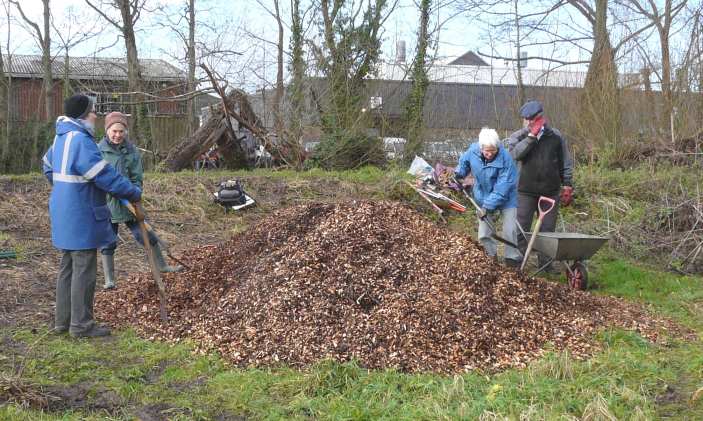
For the full report
and more photos go to . . . http://www.brook-meadow.hampshire.org.uk/bm-diary-2015a.html
I looked for Lesser
Celandines but did not find any. However there was a
good display of Hazel catkins on the west bank of the
river south of the north bridge; some of the catkins
were open.
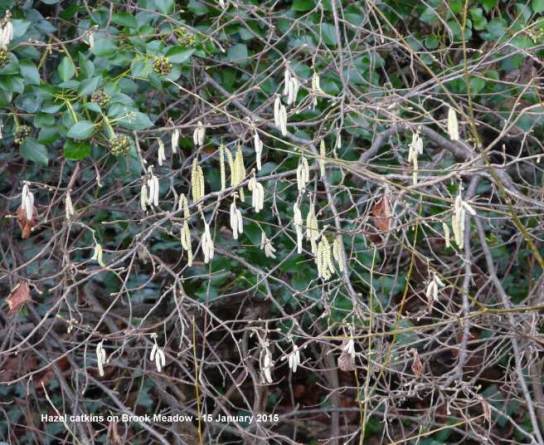
Oaks
retaining leaves
I was
interested to see that leaves were still present on
one of the Oak saplings that were planted on the
Seagull Lane patch for the Jubilee year in 2012,
actually the one that was planted by me! The other two
Oaks that were planted at the same time have lost
their leaves.
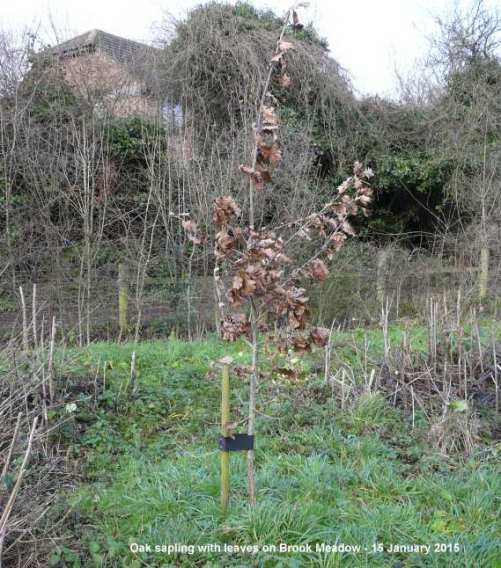
From the internet I
learned that this persistent leaf trait is termed
marcescence. There are quite a few members of Quercus
family that behave this way - as well as other
species, such as, Beech and Hornbeam. The Beech hedge
in Bridge Road also retains most of its leaves.
Wikipedia indicates some possible benefits of this
behaviour in that marcescent leaves may deter grazing
animals, help water balance and protect the plant from
cold injury.
Langstone
Mill Pond
Peter
Milinets-Raby dodged the showers this afternoon for a
visit to the Langstone Mill Pond (12:53pm to 2:44pm -
very low tide - blustery wind with bright sunny
intervals).. The highlights were as followed:
Langstone Mill Pond: 5 Teal, Male & female Wigeon
- showing well in the sunshine (photo attached),
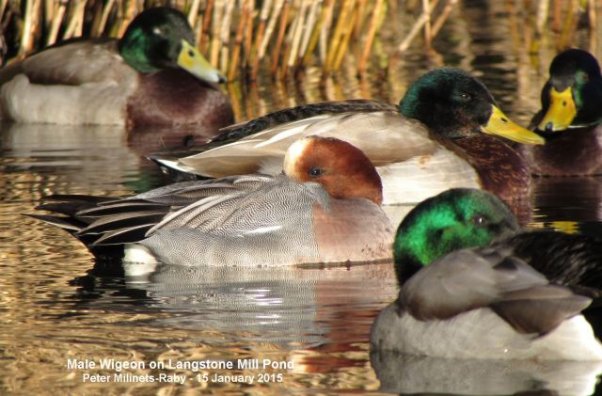
All three Grey Heron
nests occupied. The two nests in the Holm Oak just
held a single sitting bird each and the one to the
south had two birds standing on it. 30+ Goldfinch.
Female Goosander. Turned up on the pond from
2:20pm. Bathed vigorously, then stood on the tree at
the very rear of the pond and preened.
Flooded Horse Paddock: 101 Teal, 16 Moorhen, 2 female
Pheasant, 12 Mallard, 14 Little Egrets roosting.
Kingfisher perched for quite a while on the seaweed
posts in the mill outflow.
Off Pook Lane: Searched for the Curlew Sand, but could
not find it. Looking at Dunlin in bright sunshine is
very difficult. Over cast conditions are much better
to see subtle differences. 2 Greenshank
(G//R+BRtag//-) - record phone photos attached,
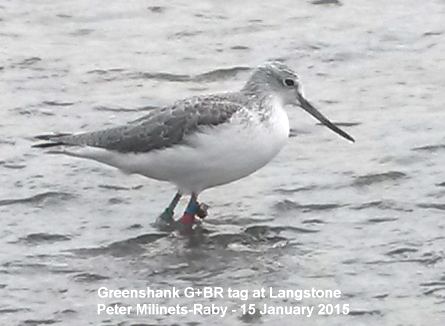
416 Dunlin, 27 Knot,
82 Shelduck, 10 Grey Plover, 176 Lapwing, 150+ Golden
Plover, 3 Red Breasted Merganser, 1 Bar-tailed Godwit,
1 Avocet - feeding in the deep muddy gullies and only
seen occasionally.
Blackcaps
in garden
Patrick Murphy
sent me the following photo of a female Blackcap
feeding on a bird cake in his garden taken about
lunchtime yesterday. Patrick says she has been coming
for the last 3 days.
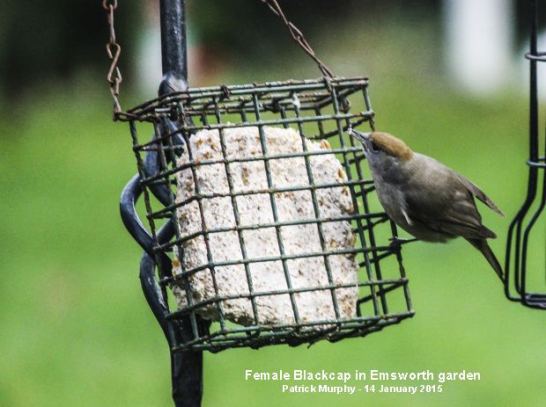
I too have had a
regular female Blackcap in my garden, but not to the
feeders. This one feeds exclusively on the droppings
beneath one of the sunflower heart feeders.
WEDNESDAY
JANUARY 14 - 2015
A
Water Vole at last
At last, after
so many hours searching for a Water Vole, Malcolm
Phillips finally got his reward today when he saw one
at 14.48 at the north west corner by the culvert. Here
are two photos of the same animal for good measure.
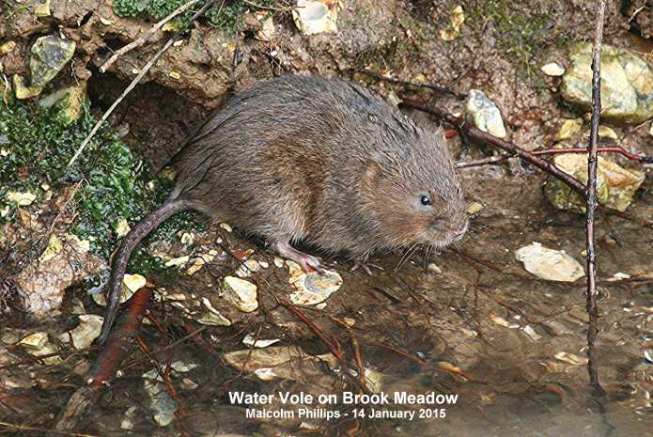
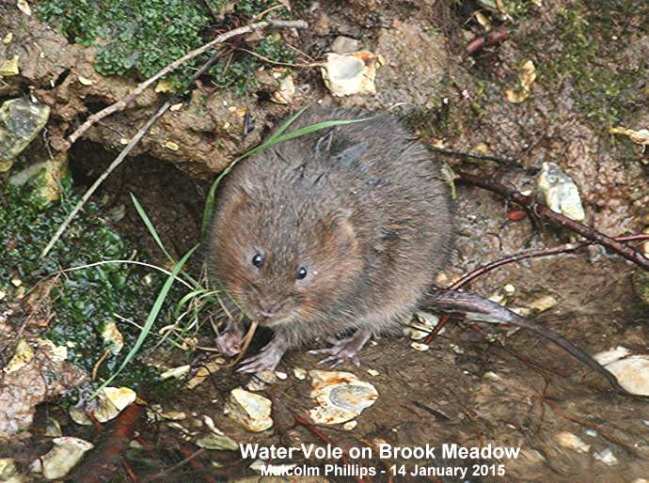
This was our first
Water Vole sighting on Brook Meadow since 30-Sep-14
and our first of 2015. So, well done again to Malcolm.
Interestingly, it was in Section A of the river where
we had no sightings at all in year 2014. As can be
seen from the following chart, 2014 was a poor year
for Water Vole sightings on Brook Meadow, despite the
valiant efforts of Malcolm Phillips and others.
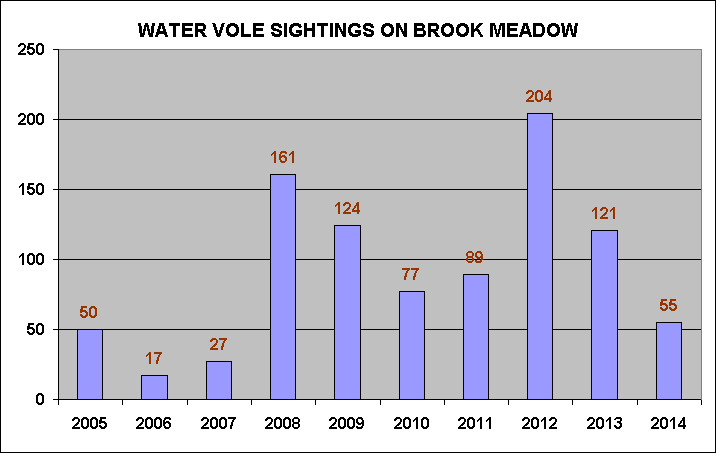
For all the Water Vole
sightings and photos over the years go to . . .
Water
Voles
Siberian
Chiffchaff
Malcolm also
got another photo of the Siberian Chiffchaff by the
gas holder.
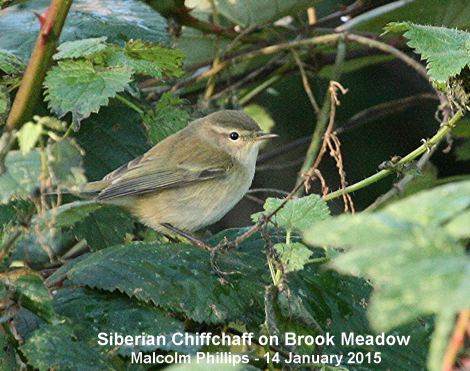
The
Brook Meadow Choir
Mike Wells did
a loop of Brook Meadow this morning and saw at least
two Chiffchaffs near the gasometer, one of which was
probably the Siberian. Mike sent two photos of the
'Brook Meadow Choir', who were really 'going for
it!
Reed
Buntings on Peter Pond
Following Tony
Wootton's sighting of two males last week, Neill
Foster watched a pair of Reed Buntings this morning in
the reeds on the south side of the Lumley Stream
footbridge to the north of Peter Pond. He saw the
female first, very close, feeding on the seeds. It was
soon joined by the male. They were feeding around
there together for about five minutes.
Here
is a photo that Malcolm Phillips got of a female Reed
Bunting
in the reedbeds on Peter Pond a couple of years
ago
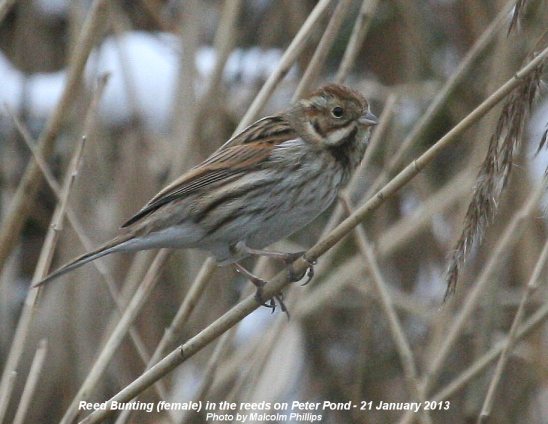
Neill asked if Reed
Buntings breed in the locality? My guess is they
probably do though I have no direct evidence of it.
The habitat is certainly right on Peter Pond and they
are seen here in spring and summer as well as winter.
The nearest place for confirmed breeding of Reed
Bunting is Thorney Little Deeps (Birds of Sussex p.
581).
Overall, BTO research indicates a rapid decline in
Reed Bunting numbers during the 1970s, but since then
it has fluctuated without a clear trend. The initial
decline placed Reed Bunting on the red list but in
2009, with evidence from BBS of some recovery in
numbers, the species was moved from red to amber.
There has been a widespread moderate decline across
Europe since 1980.
See . . . http://blx1.bto.org/birdtrends/species.jsp?s=reebu&year=2014
Langstone
Mill Pond
Peter
Milinets-Raby popped briefly to the Langstone Mill
Pond this morning (10:02am to 11:16am - very low
tide). The highlights were as follows:
Langstone Mill Pond: male and female Wigeon, All three
Grey Heron nests occupied, with birds that look like
they are already sitting! 2 Teal, Kingfisher,
Flooded Horse Paddock: 8 Little Egret, 2 Grey Heron,
109 Teal, 21 Moorhen, 4 Mallard,
Off shore off Pook Lane: 16 Red-breasted Merganser, 3
female Goldeneye, 60 Shelduck, 7 Knot, 29 Lapwing,
Just 46 Dunlin, 1 Avocet (feeding for once along the
waters edge). 53 Bar-tailed Godwit, 8 Grey Plover, 1
Greenshank (G//R+BRtag//-), 70+ Brent Geese.
TUESDAY
JANUARY 13 - 2015
Brook
Meadow
It was a
beautiful morning for a walk through the meadow. The
sun was shining, the birds were singing and spring was
in the air! The main birds in song were Robin,
Dunnock, Wren, Great Tit and Collared Dove, though the
distinctive notes of a Song Thrush could be heard
wafting across from the east side of the meadow.
I met the ever-present Malcolm Phillips on the main
path. He had just seen a Goldcrest in the Palmers Road
copse, probably the same bird that Francis Kinsella
photographed for the blog on Sunday Jan 11. Malcolm
also saw two Blue Tits investigating one of the
concrete nest boxes in Palmer's Road Copse and got
this shot of one emerging. Spring is certainly in the
air!
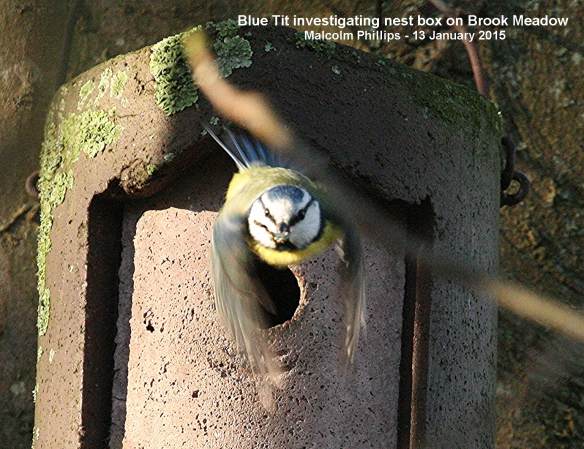
Nore
Barn
13:30 - 14:00
- I got to Nore Barn about 3 hours to high water. A
fierce SW wind was blowing which made birdwatching a
little tricky. A flock of Brent Geese were feeding on
the near shore, including a good number of juveniles
which still have their white wings bars.
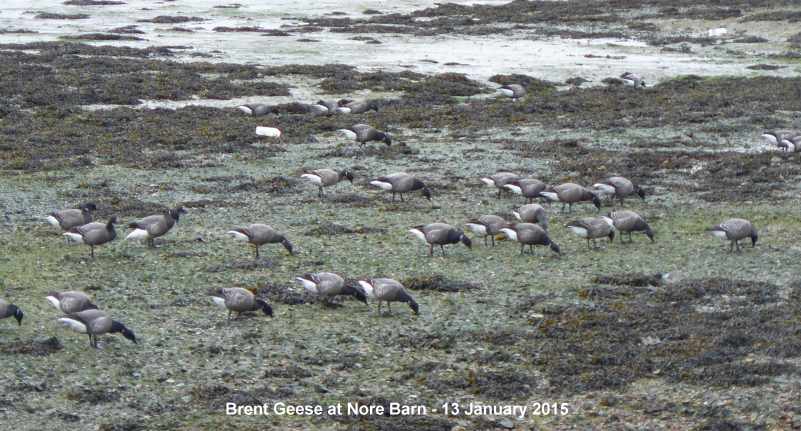
Wigeon were the most
numerous of the ducks with a few Teal only. No sign of
any Pintail today. A flock of around 130 Dunlin were
feeding busily on the edge of the shore along with 15
Black-tailed Godwits. None of the godwits were ringed.
There were several hundred more Dunlin on the fast
receding mudflats to the east of Nore Barn. Two
Spotted Redshanks were in the stream at about
2pm as I was leaving, one feeding in the stream the
other snoozing nearby. Here is one feeding in the
stream.
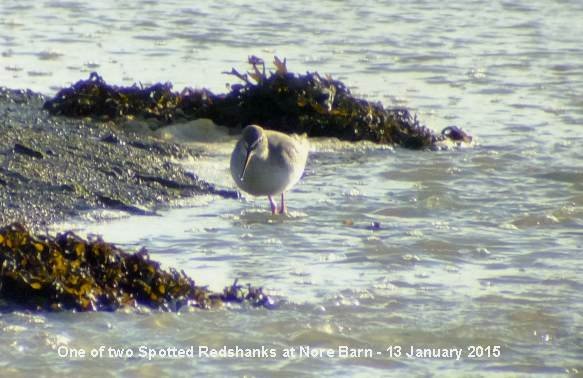
MONDAY
JANUARY 12 - 2015
Firecrest
in Havant
Martin Hampton
saw my comment in last night's blog entry hoping for a
Brook Meadow Firecrest, so he thought he would share
his own sighting of one today whilst working on his
group's tiny conservation area in south Havant. He
thought it might be the same one he saw briefly in a
Birch in his front garden earlier this week. He said,
until that sighting, there had only been Goldcrests in
the Hollies and Bay Trees, so perhaps it is also not
too late for one or more to turn up at Brook Meadow
too. Hope so.
Here
is one we had on the meadow in January 2013 as a
reminder
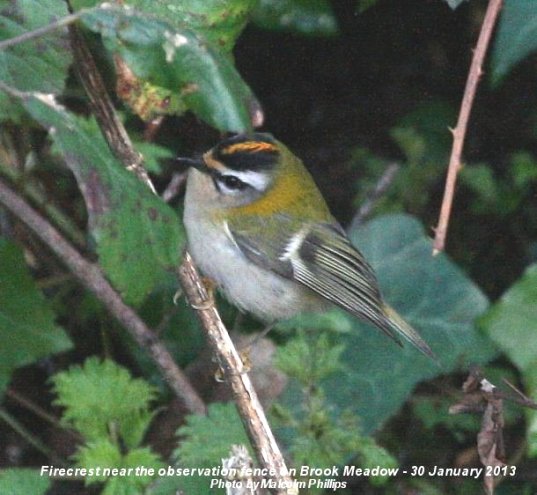
Spotted
Redshank W+GY
Caroline
French did a circular walk from Prinsted to Nutbourne
yesterday (Jan 11) and saw a colour-ringed Spotted
Redshank (W+GY) feeding in the channel at Nutbourne
Bay SU776048 at about 12:00. This bird was ringed by
Pete Potts in Oct 2008 and has been seen each winter
since then, usually at Nutbourne and Thorney. Caroline
also saw 21 Avocets roosting at the end on the shingle
spit 258 Brent Geese feeding on the field (horse
pasture) at Prinsted.
Here
is a photo of W+GY that I took in the Nutbourne stream
in 2012
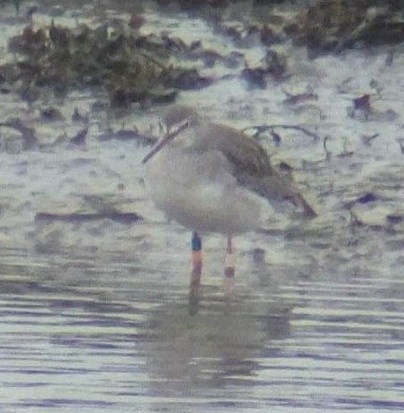
SUNDAY
JANUARY 11 - 2015
Brook
Meadow
Jean and I had
quite a sociable morning while walking through Brook
Meadow on this pleasant winter's day. We first met up
with a family near the S-bend with their young son,
Thomas, who was a keen birdwatcher! Thomas's mother
told me they had only recently moved to Emsworth and
loved my Emsworth wildlife blog! Thomas was looking
for the Siberian Chiffchaff with his binoculars. It
was so good to see a youngster keen on birdwatching.
In fact, while we standing there a Chiffchaff was
flitting around in the trees above our heads. I was
not sure if it was the Siberian or a common
Chiffchaff, but probably the latter as it seemed to
have some yellow colouring in its plumage. The
Siberian Chiffchaff is really all grey.
As we were chatting a chap came up with a smile on his
face and a big camera in his hands and introduced
himself as Francis Kinsella. Francis is a regular
visitor to Brook Meadow and often sends me photos of
birds, but we have never met before. It was good to
meet up at last. Francis told me he was on Brook
Meadow only yesterday and had sent me a photo of a
Goldcrest taken in Palmer's Road Copse. Look at
that lovely golden crest. Maybe, it is not too late
for a return of the Firecrests that we had the winter
before last?
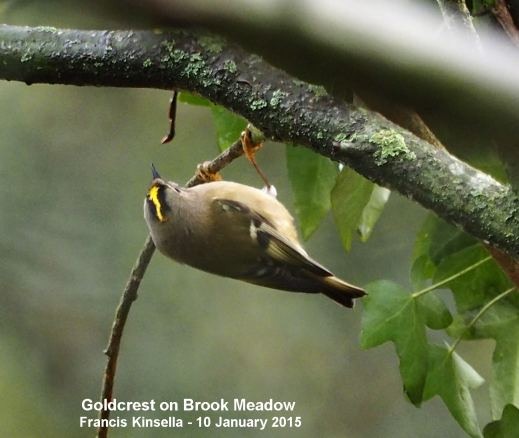
Later in the morning,
I met Malcolm Phillips who was stalking two
Chiffchaffs along the river bank near the old
gasholder in company with Barry, a birdwatcher from
Waterlooville, who was making his first visit to Brook
Meadow. Malcolm managed to get excellent photos of
both birds which clearly are very different in
plumage. I think the first is the now familiar very
grey Siberian Chiffchaff of which we have many photos
and the other, presumably a common Chiffchaff, which
has a much browner plumage.
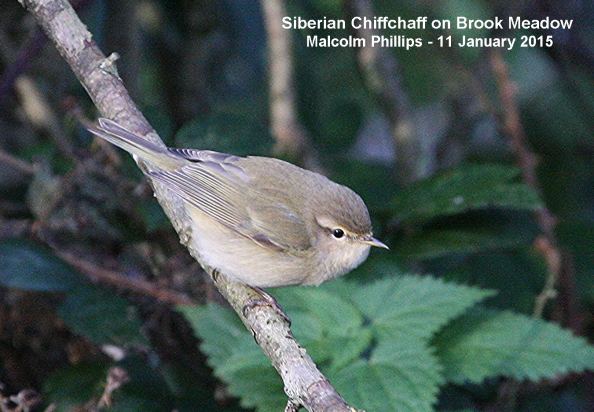
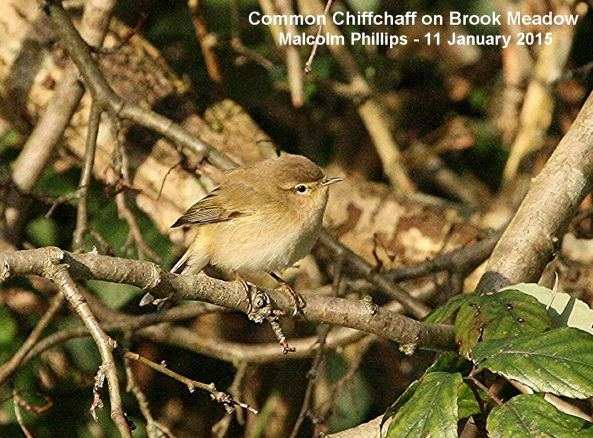
Update
on yesterday's fungi
I had an
e-mail from Jon Stokes to say that the Crack Willow I
located yesterday with the bracket fungus in Palmer's
Road Copse was, in fact, the same tree as that on
which he found the rare Big Smokey Bracket fungus
earlier in the week. However, the photo he took was of
a fungus on the other side of the tree, but he
confirmed that my photo was of the same species. Jon
also said he had taken a sample of the fungus for
close analysis, the spores were checked and discussed
with the Hampshire society and the record sent in. So,
that seems to confirm the presence of the Big Smokey
Bracket.
Jon also noticed the Velvet Shank near the south
bridge and is working on what the mystery fungus
spikes might be. Stag's Horn Fungus was his first
thought also but it did not feel quite right so he is
doing some homework and will let me know when he more
information.
Hairy
Garlic
The Hairy
Garlic plants were showing well at the eastern end of
the Lillywhite's path wayside with fresh green leaves
when I walked through this morning.
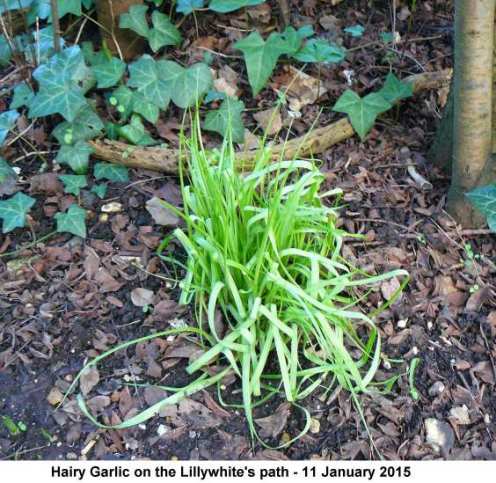
Hairy Garlic
(Allium subhirsutum) is a rare garden escape,
probably overlooked in recording. It is a
Mediterranean species with a scattering of broad, more
or less prostrate, shiny green leaves, with slightly
hairy edges, from which the plant gets its common
name. Its leaves give off a faintly garlic aroma when
crushed. Here is a close-up of a leaf with hairy
edges.
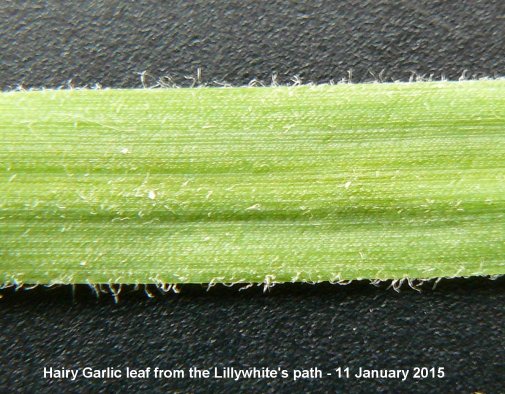
Spotted
Redshank
After leaving
us on Brook Meadow this this morning Francis Kinsella
went over to Nore Barn where he found the Spotted
Redshank performing well as usual.
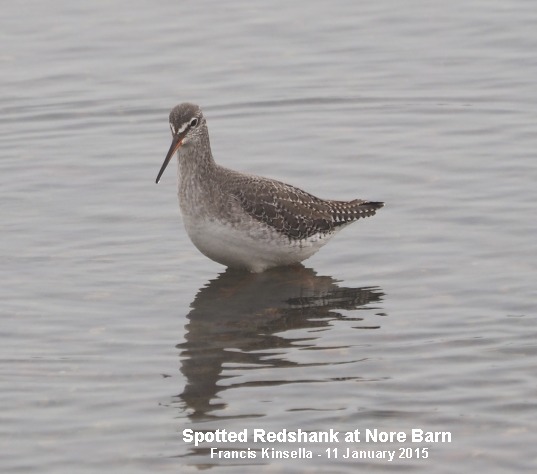
Rose-ringed
Parakeet
Today, Terry
and Paul Lifton saw a Rose-ringed Parakeet in a tree
in Westbourne Avenue, Emsworth. This is probably the
same bird that was seen by Pam Phillips in the open
grassland area at the northern end of Westbourne
Avenue on Dec 17 and prior to that by Susan Kelly in
Westbourne on Nov 30.
Snowdrops
Tony Wootton
sent me this photo of some flowering Snowdrops that he
found during the Havant Wildlife Group walk in Queen
Elizabeth Country Park on Saturday morning.
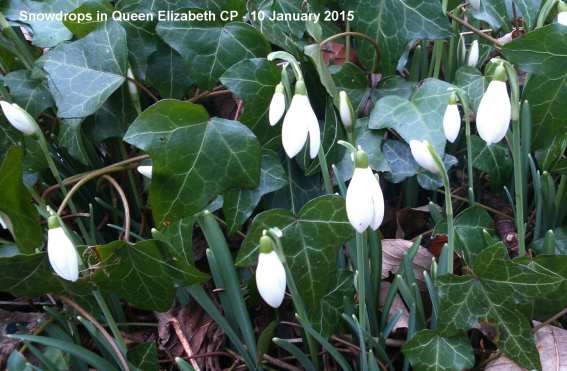
SATURDAY
JANUARY 10 - 2015
Rare
fungus
Jon Stokes
from the Tree Council had a walk around Brook Meadow
earlier in the week and came across a bracket fungi 10
feet up on one of the Crack Willows in Palmer's Road
Copse adjacent to the car park behind Tescos. It
turned out to be Big Smokey Bracket
(Bjerkandera fumosa) which is nationally scarce
with only 2 previous Hampshire records.
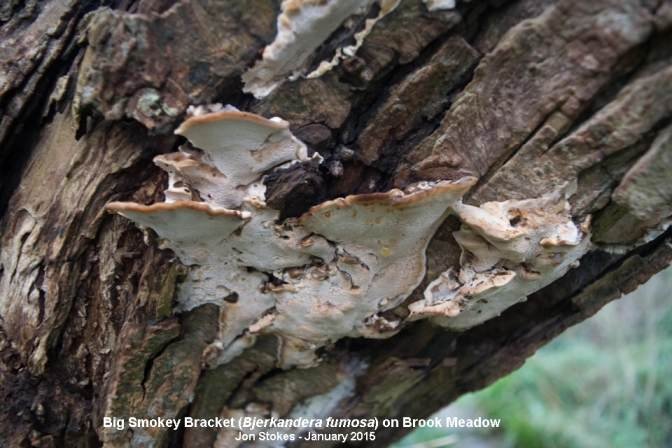
It occurs on decayed
wood of deciduous trees, most frequently on large
stumps of Sycamore (Acer pseudoplatanus) but is
also known on other species including Willows
(Salix) as in this case. It is described as
'Occasional but widespread, sometimes locally common,
especially where Sycamore scrub is cleared. Basidiomes
in active growth often smell strongly of anise'.
According to my book, it differs from the more common
Grey Polypore (Bjerkandera adjusta) in having
cream coloured pores rather than dark grey ones.
More
fungi
I went over to
Brook Meadow have a look for the fungus this
afternoon. I found what I thought was the Big Smokey
Bracket on the large Crack Willow tree (numbered
000605) that leans over the main path through Palmer's
Road Copse.
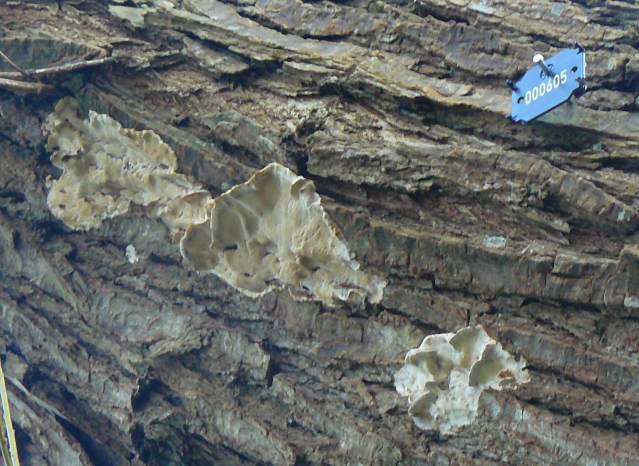
The white line on the
photo indicates the site of the fungus on the tree.
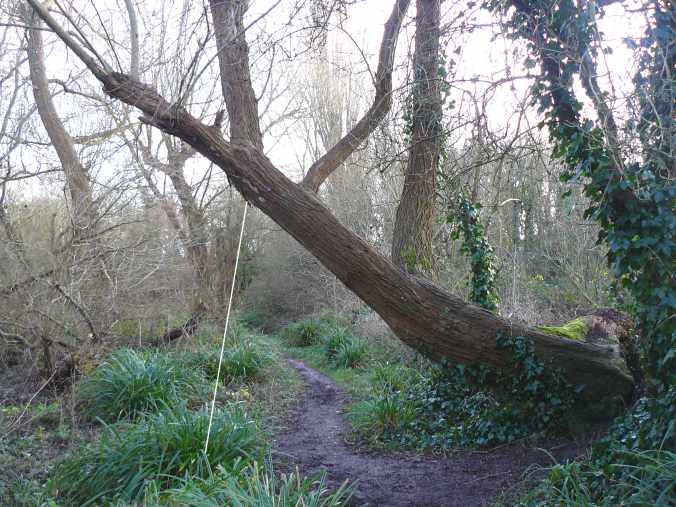
However, comparing my
photo with that of Jon Stokes the two are of similar
fungi, but clearly not the same. I have no idea what
mine is, but it looks like a bracket, though it is
rather flat against the bark of the tree. I shall need
to get a more precise location for the Big Smokey
Bracket from Jon.
While I was in the
copse I had a look at the prominent jelly like fungus
growing on a couple of the small smaller trees at the
eastern end of the south bridge - meadow side. I
thought at first it looked like Jelly Ear though I am
now fairly certain that is not correct as these fungi
are far too bright orange and have gills. My guess is
that they are Velvet Shank which continue
fruiting through the winter.
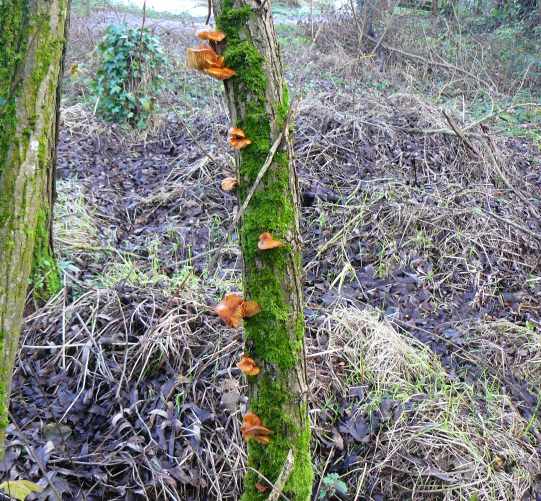
Growing alongside the
Velvet Shank fungi were a group of stick-like objects
about 1 inch in length, very stiff and pointed. My
very wild guess is they are old Stag's Horn Fungi.
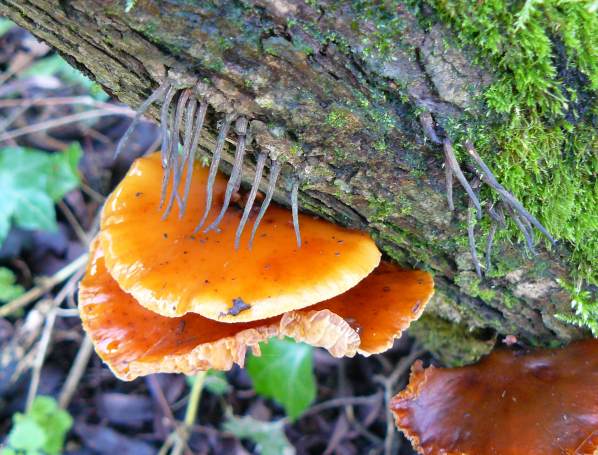
Update
on fungi
I had an e-mail from Jon Stokes (11-Jan) to say I did
find the correct tree for the Big Smokey Bracket
fungus in Palmer's Road Copse, but the photo he took
was on the other side of the tree. He had to hold his
camera up on a pole to get his picture. Both his and
mine were the same fungus.
Jon was also puzzled by the spike fungi near the
Velvet Shank. Stags horn was his first thought also
but it did not feel right so he is doing some homework
and will let me know when he more information.
Butterbur
buds
I found a good
number of Butterbur buds starting to push up and
sprout in the area below the main seat. One can just
see the first signs of the distinctive pink flower
spikes inside the partially open bud in this photo.
Weather permitting they will soon be emerging in all
their glory.
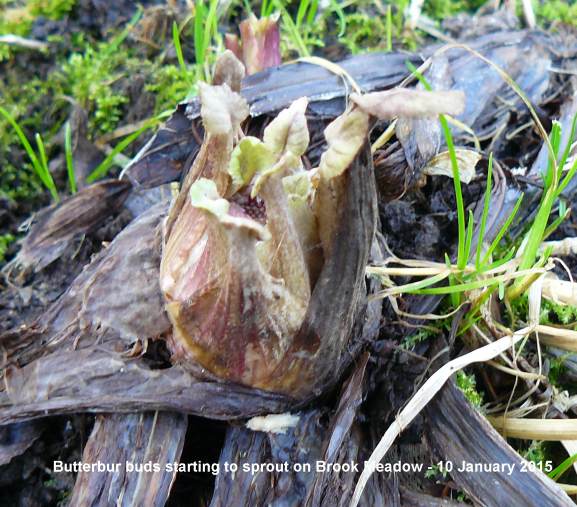
Chiffchaff
While I was
looking at the bright orange fungi I could hear the
call of a Chiffchaff coming from the trees along the
path to the south bridge. I could clearly see the bird
high in the branches, but could not say if it was a
Siberian Chiffchaff. However, the call sounded very
much like that of a regular common Chiffchaff.
Malcolm's
news
Malcolm
Phillips was also on Brook Meadow this morning between
the showers, but did not see much apart from the usual
friendly Robin.
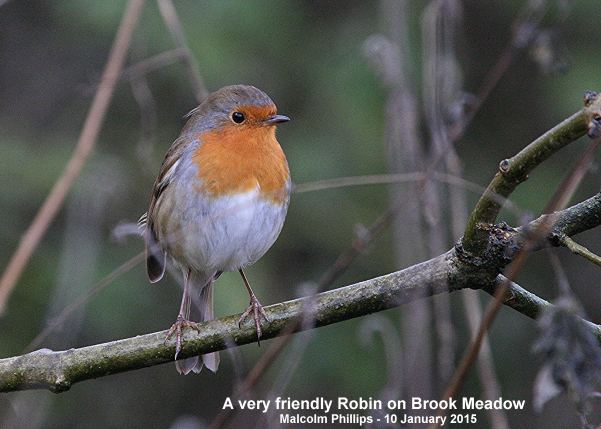
Then went down the
bottom of Slipper Pond and again saw the female
Kingfisher as it dived in for fish. Is this always the
same female bird we are seeing over and over again?
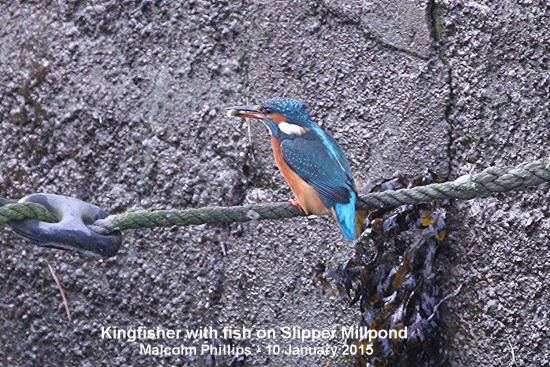
FRIDAY
JANUARY 9 - 2015
Nore
Barn
11:00 - I
cycled over to Nore Barn by about 3 hours to high
water. I was forced to walk along Western Parade
against a strong SW wind. When I got to Nore Barn I
headed for some known sheltered spots behind bushes.
However, the wind appeared to slacken when I was
there.
Just one Common Redshank was feeding in the upper
stream when I arrived. About 70 Dunlin were feeding in
their typical fast and furious manner on the mudflats,
but there was no sign of any Knot. Three pairs of
Pintail were swimming in the channel with the elegant
males showing very well.
What was probably the regular Spotted Redshank
was snoozing on the edge of the lower stream. A bit
later (11:30), it was joined by a second Spotted
Redshank which settled quite close by.
Surprisingly, I have seen nothing of the regular
colour-ringed Greenshank G+GL since Dec 5. I think it
must have found another feeding site.
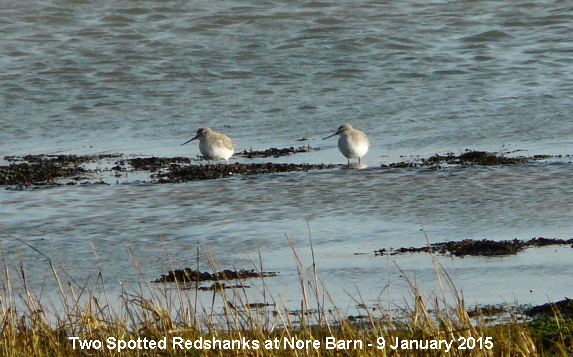
I counted 48
Black-tailed Godwits variously feeding and
snoozing along the edge of the channel from the
stream. I could only find one colour-ringed bird among
them, the very regular, WO+LW flag, its flag
standing out very clearly as an aide to
identification. As the tide came in, most of the
godwits moved into the channel south of the woods
where I could see lots of 'spurting' behaviour as they
fed in the in the shallow water. The sun was in the
wrong place for photos, but this silhouette shows the
bird on the right spurting water from its bill.
For more information about spurting behaviour in
waders see . . . Spurting
behaviour
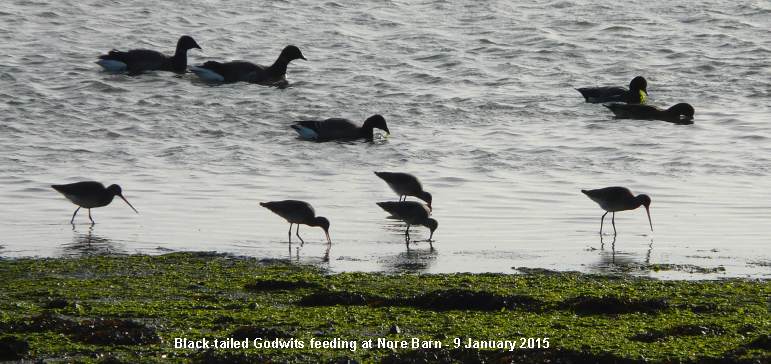
Garden
Greenfinches
This winter I
have seen definite signs of a return of Greenfinches
to my garden after a fairly lengthy absence due to the
illness trichomonosis which first struck the species
in 2006 and, according to the BTO reduced their total
population by about a fifth. When the disease started
Greenfinch was my number one garden bird with 100%
weekly presence throughout the year and a peak count
of 54 in 2003. However, from 2007 Greenfinch sightings
dropped dramatically and they became very scarce as
shown in the following chart of the average weekly
counts in the garden.
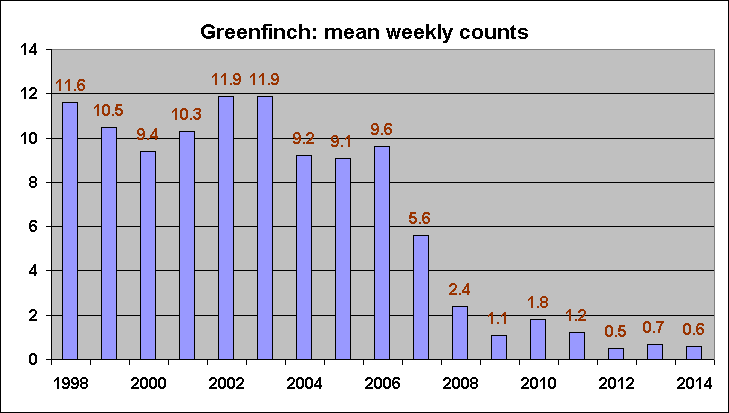
For the past 3 weeks I
have seen up to 7 Greenfinches feeding on the
sunflower heart feeders. Here is a shot of them taken
this afternoon.
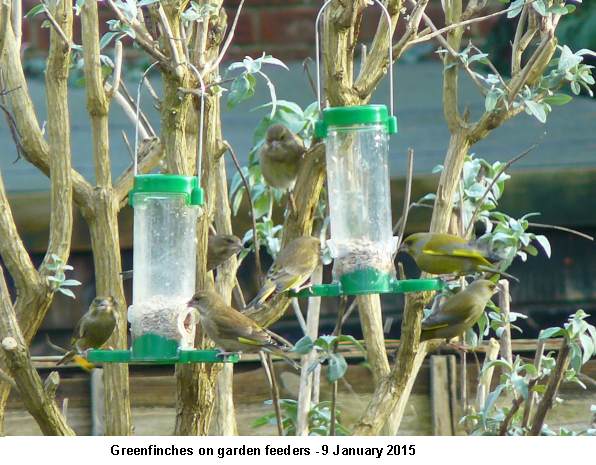
Though I have to admit
their presence is a mixed blessing as I have to fill
up the feeders on a daily basis and sunflower hearts
are not cheap! But the birds love them, especially
Goldfinches, which usually share the feeders
with the Greenfinches.
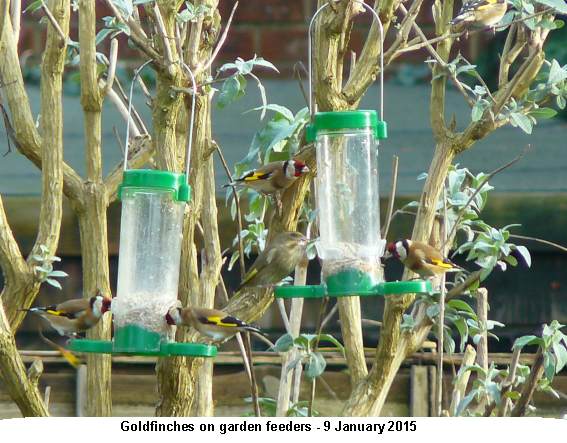
I forgot to mention,
yesterday we had a Red Admiral butterfly
fluttering around in the garden - the first of 2015.
Mystery
Chiffchaffs
Malcolm
Phillips went round Brook Meadow this morning and saw
a Chiffchaff in the south meadow. He then walked up to
the cleared area south of the S-bend in the river and
saw another Chiffchaff. He is not sure which of the
two is the Siberian Chiffchaff. Or maybe they both are
Siberian Chiffchaffs! Malcolm has put the two shots
together on one image to get a better comparison. The
lower one was from the south meadow and the upper one
from the S-bend. Note neither of them is ringed.
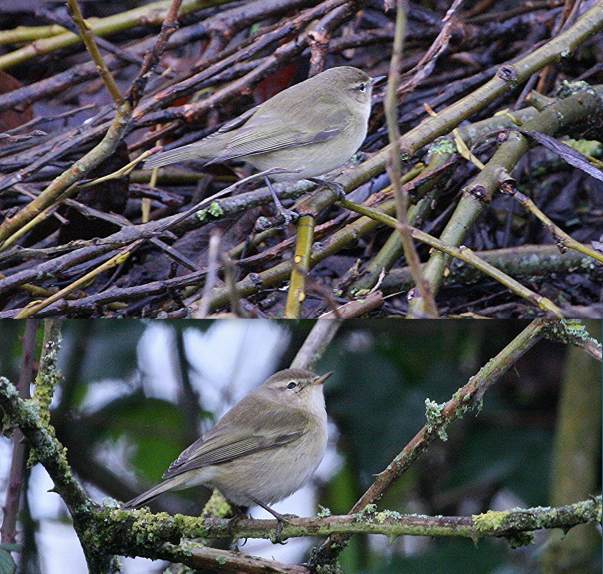
Kingfisher
at Gooseberry Cottage
Yesterday,
Malcolm Phillips walked round Brook Meadow but did not
see a lot apart from water. The river was running high
and flooding its banks in Palmer's Road Copse. Malcolm
also got yet another snap of our now very familiar
female Kingfisher perched as usual on the decking on
Gooseberry Cottage.
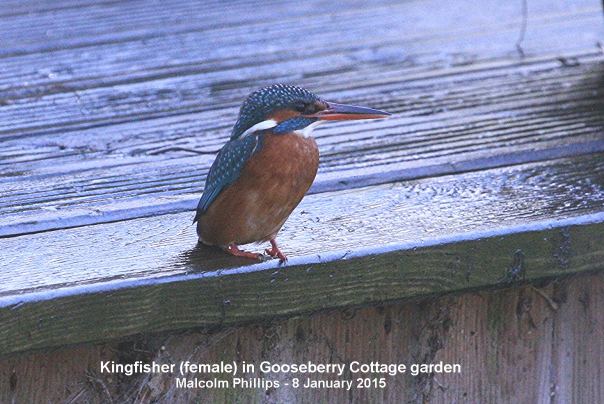
Early
buttercup
Chris Oakley
sent me this very welcome picture of an early
Buttercup which his wife Ann took in Warblington Road.
In such a mild winter one never knows what might
suddenly spring up, as if it were spring.
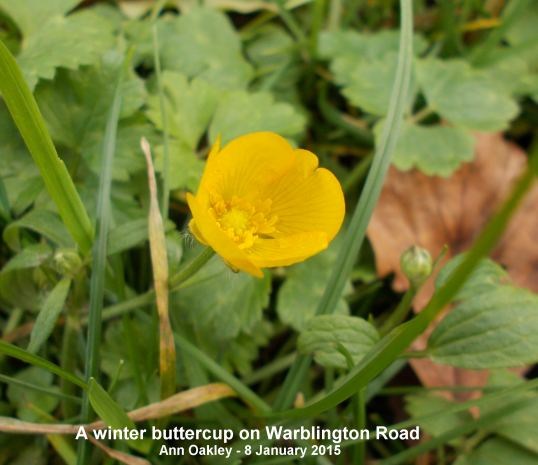
Mystery
moth
Caroline
French I came across a well-camouflaged moth on the
wall at Emsworth railway station on 6th Jan. She has
not been able to identify it and wonders if anyone
else knows what it is. My very very tentative guess is
an Eggar Moth.
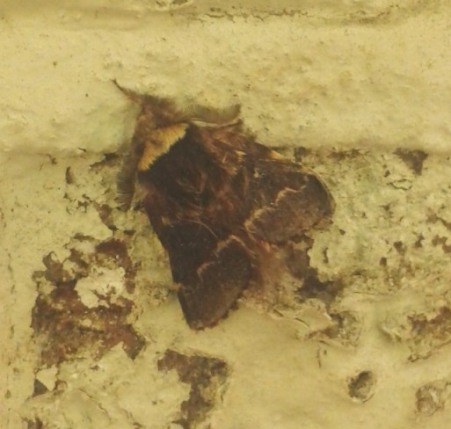
Ralph Hollins is
pretty sure Caroline's moth is a male December
Moth. He says, "My guess that it is a male is
based on the broad antennae which males depend on to
track down females by the pheremones they give off. My
guess as to the name is based on the December Moth
being one of the most numerous species at this time of
year and by comparing Brian's photo with photos on the
UK and Hants Moths websites. Note that both these
websites give you a set of images to look at so if the
main image presented when you visit the site is not
convincing you can replace it with others - with UK
Moths you click the smaller images to select them,
with Hants Moths you click the left or right arrows
below the main image".
See . . . http://www.hantsmoths.org.uk/species/1631.php
. . . and . . . http://ukmoths.org.uk/show.php?id=3897
Barry Collins also
confirmed the moth's identity as December Moth.
Langstone
Mill Pond
Peter
Milinets-Raby popped down to the Langstone Mill Pond
this morning ahead of an incoming tide (10:14am to
11:40am). The highlights were as follows:
Flooded Horse paddock: 9 Little Egret roosting, 1 Grey
Heron roosting, 2 Grey Heron collecting sticks in far
corner of the paddock - more later. 119 Teal. 29
Moorhen. 15 Mallard. 1 Skylark over.
Langstone Mill Pond: Yes, 2 Grey Heron collecting
sticks and flying to the trees with them - watched
this happen on five occasions. So, went back to the
pond and discovered 3 pairs of Grey Heron in the same
three nest sites as last year. The pair halfway down
the Holm Oak on the left were well ahead of the other
two pairs with lots of displaying and stick fiddling
as if there may even be eggs!! The other two pairs
were just collecting sticks and re-arranging them.
Spring is certainly in the air!
On the pond at the back were 2 further roosting Grey
Herons (so 9 in total), Male and female Wigeon (though
the male was not to be seen towards mid-day).
Off shore, towards Pook Lane: 6 Greenshank
(RG//-+YY//- and G//R+BRtag//- and G//R+BB//-), 5
Knot, 181 Dunlin (no sign of the Curlew Sandpiper,
though the waders left very early before the tide had
pushed in). 5 Grey Plover, 21 Golden Plover, 66
Shelduck, 29 Black-tailed Godwit, Adult winter Med
Gull, 85 Lapwing.
The same Kingfisher seen three times dashing over
pond, over the mud flats and on the posts by the old
mill (this bird has a chunk missing out of its wing,
two or three feathers).
Out on the channel: 2 female Goldeneye, 5 Red-breasted
Merganser.
THURSDAY
JANUARY 8 - 2015
Local
news
The only
report I had today was from Tony Wootton. He had a
mooch around the local area this afternoon. Starting
with Brook Meadow, he met Malcolm Phillips who has not
seen the Siberian Chiffchaff since Thursday. Could it
have left?
Tony watched a Kingfisher fly very high from over the
railway and then up Seagull Lane. Probably going
towards my back garden, he though, but I was not there
to see it sadly. Kingfishers are everywhere this
winter.
He met another walker who had a Goldcrest by the
little bridge over the Lumley Stream. Finally, Tony
saw two male Reed Buntings very close to the
Kingfisher table on Peter Pond. Their head markings
were showing nicely.
WEDNESDAY
JANUARY 7 - 2015
Brook
Meadow
I had a walk
round the meadow this morning. I met Brian Lawrence
and we walked down the main river path together,
stopping from time to time to play a recording of a
Siberian Chiffchaff song on my digital recorder. There
was no response from any Chiffchaff, though it did
attract a Robin into song and also a Blue Tit
which gave a brief burst of its sweet song, the first
I have heard this winter.
We met Malcolm Phillips who had been on the meadow for
some time already, but had seen little apart from
Long-tailed Tits and Song Thrush. The three of us
waited on the south bridge for something to happen,
but nothing did.
Kingfisher
on Peter Pond
Brian and I
walked over to Gooseberry Cottage, but there was no
sign of the Kingfisher which Malcolm photographed
yesterday. Walking back down Lumley Road I spotted a
Kingfisher flying fast and low over Peter Pond,
probably coming from its regular perching table in the
reeds. Yesterday, Malcolm Phillips got this great
action photo of the female Kingfisher flying back to
it perch on the table after fishing in the pond.
Always the female!
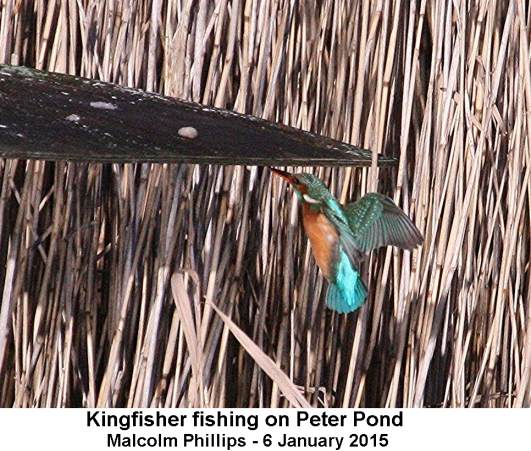
Wintering
Coot in Emsworth Harbour
I walked down
to the main harbour at the bottom of South Street from
where I could see a mass of Coot bobbing up and down
on the choppy waves. This is the first of the winter
gathering that I have seen this season. I counted a
total of 104 Coot in the harbour, some near the quay,
but most near the east shore. There was another 18 on
the town millpond and a few more on Slipper Millpond,
so the wintering population is building up.
Ringing
records
The BTO
website has published a page summarising all
recoveries of ringed birds that have moved to or from
Hampshire. The accompanying map shows all records of
birds ringed in Hampshire and recovered abroad
(purple) and birds ringed abroad and recovered in
Hampshire (orange) from 2006-13.
For each species a table then summarises the number of
birds that have moved between different counties of
Britain and Ireland and other countries. First are
listed the number of birds ringed elsewhere in Britain
and Ireland and found in Hampshire then the number of
birds ringed in Hampshire and found in another county
in Britain or Ireland. In the next columns are listed
the number of birds ringed in a country abroad and
found in Hampshire and the number of birds ringed in
Hampshire and found in other countries abroad. See . .
. http://blx1.bto.org/ring/countyrec/resultsall/recGBHAall.htm
TUESDAY
JANUARY 6 - 2015
Nore
Barn
It was quite a
nice afternoon, so I got the bike out to deliver the
Brook Meadow printed newsletters in the Beach Road
area. I called in at Nore Barn where I haven't been
for almost 3 weeks. I have missed it and so it was
good to get back there to see some of my feathered
friends again. The tide was falling and the old
faithful Spotted Redshank was feeding in the
stream along with a large flock of 18 Mute Swans.
However, the very bright sun made photography
difficult.
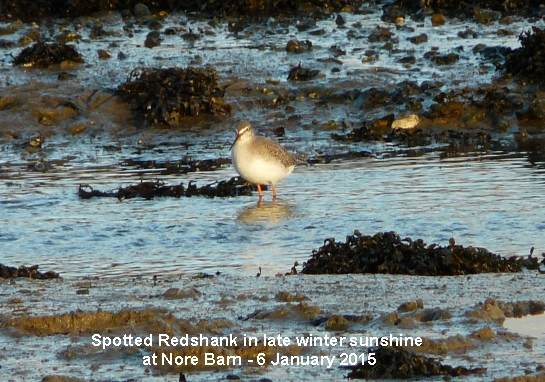
I could see the
Black-tailed Godwits assembling on the emerging
mudflats in the Nore Barn channel. Checking for
colour-rings was not easy as I did not have my scope
and the sun was very low and bright for photography.
However, I managed to find three colour-ringed birds,
all regulars at Nore Barn this winter: G+WR, B+GO and
WO+LW flag. By the time I left I counted a total of 82
Black-tailed Godwits. Here are just a few of them in
the winter sunshine.
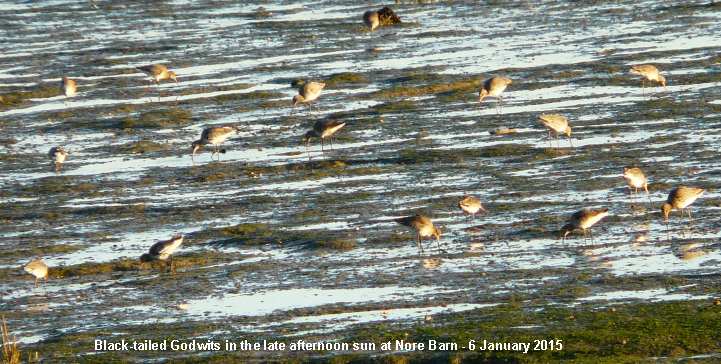
Ralph Hollins came up
on his bike from the Warblington direction, having
seen the female Goosander on Langstone Mill Pond
reported yesterday by Peter Milinets-Raby.
Langstone
Mill Pond
Peter
Milinets-Raby took a walk along past the Langstone
Mill Pond this morning as the tide pushed in and
before the drizzle moved in (9:15am to 11:20am). The
highlights were as follows:
Off shore from the pond: A single Avocet asleep and
when the tide pushed in, it flew to the "island" in
the middle of the channel and fell sleep again!! 33
Black-tailed Godwit. 220+ Brent Geese. 73 Shelduck. 7
Grey Plover. 190+ Dunlin. Single Turnstone. 63
Lapwing. 2 Bar-tailed Godwit. 25 Golden Plover with a
flock of 65+ east down the channel.
Winter plumaged Curlew Sandpiper - again good
views, but vanished after 15 minutes.
Peter
poses a puzzle in this photo. Find the Curlew
Sandpiper among the Dunlin.
My guess is that it is the isolated bird on the
right
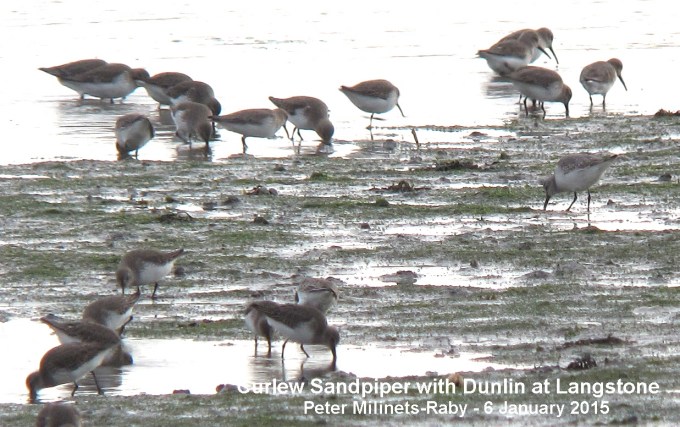
8 Greenshank
(RG//-+YY//- and G//R+BRtag//-). 22 Red Breasted
Merganser. 4 female Goldeneye. 17 Wigeon. 2 male and 3
female Pintail off Conigar Point, then flew off and
headed south. Kingfisher perched on the wreck by the
old mill, then later seen perched briefly on the trees
at the edge of the pond.
Langstone Mill Pond: Male and female Wigeon together
at the rear of the pond. Grey Heron roosting. Flock of
25+ Goldfinch milling about all morning. Cetti's
Warbler heard singing twice from the reed bed by the
flooded horse paddock.
Met up with Ralph Hollins and his arrival brought that
extra bit of luck. Initially there was no sign of the
Goosander, but as the tide pushed in to its highest
level, the female Goosander appeared at the
rear of the pond. It was very busy having a thorough
wash, then moved to the "beam/pipe" at the rear of the
island where it preened until the drizzle forced me to
leave.
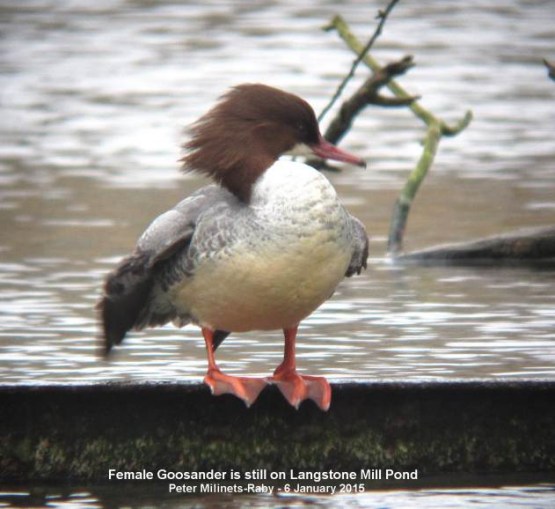
Flooded horse paddock:
The 55 Teal initially on the last bits of exposed mud,
moved to the paddock as the tide pushed in to swell
numbers to 96 Teal with 7 Moorhen.
MONDAY
JANUARY 5 - 2015
Brook
Meadow
I was
determined to get out for a while this morning despite
the chest infection telling me to stay in the warm. I
was pleased I did. It was so good to hear bird song
with both Robin and Great Tit singing well and I also
heard a Song Thrush singing from the Lumley area.
I had a look at the bramble hedge around Gooseberry
Cottage that had been cut during the special
'community' workday yesterday. I was surprised to find
about 10 one metre gaps in the hedge giving clear
access through to the garden. Apparently, this work
has something to do with controlling the flood risk to
the cottage, but I don't understand how.
I happened to meet up with my friend from the Havant
Wildlife Group Ros Norton who was hoping to catch
sight of our Siberian Chiffchaff. While we were
talking, up came the man who first discovered the
bird, Malcolm Phillips. However, he had not seen
Siberian Chiffchaff either today, but pointed out the
pile of wood chippings alongside the main river path
as a favourite spot for the bird.
For recordings of the Siberian Chiffchaff song go to .
. . http://www.xeno-canto.org/explore?query=Phylloscopus+collybita+tristis
Kingfisher
Malcolm showed
us yet more photos of a female Kingfisher, probably
the same one that Malcolm has been catching on Peter
Pond and Dolphin Quay. This one was perched on a
flower pot on the decking of Gooseberry Cottage
overlooking the garden pond. Verity Ingram had tipped
him off that this was a favoured place for the
Kingfisher to fish. What cracking photos!
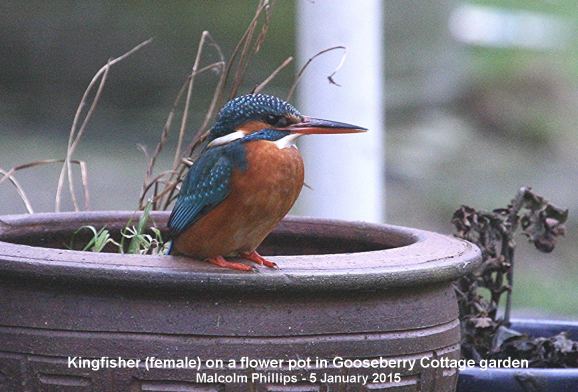
Here is the Kingfisher
with a fish caught from the garden pond
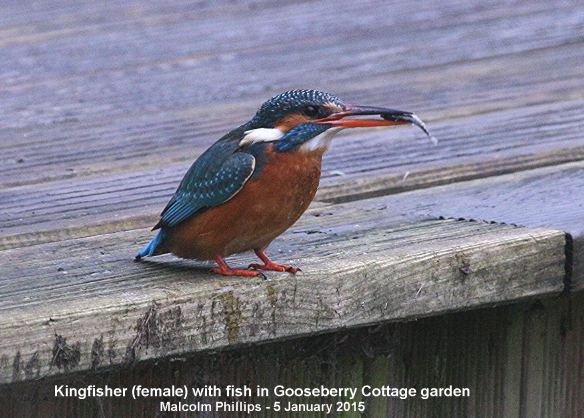
Langstone
Mill Pond
Peter
Milinets-Raby went down to the Langstone Mill Pond
this afternoon (1pm to 2:25pm - high tide mostly, then
the last twenty minutes the tide started to go out).
The highlights were:
Langstone Mill Pond: Female Wigeon on her own when I
first walked passed, then at the end of the visit she
was asleep at the back of the pond with the male next
to her. A gun shot went off on the north Hayling shore
and these two ducks were the only ones that flinched
and actually looked alarmed - Wild!! Chiffchaff
calling. 3 Grey Heron roosting. Stock Dove.
A female Goosander discovered at the very rear
of the pond. Very agitated with the Mallard and
consequently after only a few minutes it flew off and
landed out in the channel where I watched it feeding
on its own with 15 Red Breasted Mergansers
nearby.
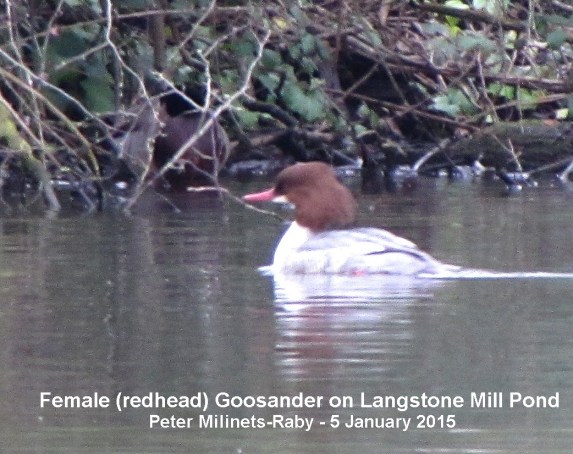
Horse paddocks: 14
Teal. Grey Heron (probably responsible for dislodging
the Teal). 20 Moorhen.
On the high tide waters: 50 Teal. 2 female
Goldeneye. 42 Shelduck with 10 off Conigar Point.
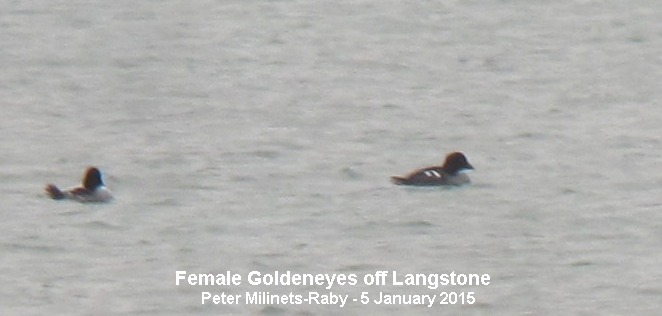
On the Castle Farm
fields were 354 Brent Geese.
As the tide turned, a flock of 60+ Bar-tailed Godwits
flew up the channel with 200+ Dunlin. In flew 10+
Dunlin, 20+ Redshank, 2 Grey Plover, 55+ Golden
Plover, and 3 Greenshank (one with rings -
G//R+GR//-).
Farlington
Marshes
Graham Petrie
had a good time at Farlington Marshes today with
Stonechats (M+F), Marsh Harrier, Red-breasted
Merganser, a raft of 24 Great Crested Grebe, a group
of 8 Snipe, and last but not least approx. 65
Avocets on the lake. Here is Graham's digiscoped
pic of a few of them.
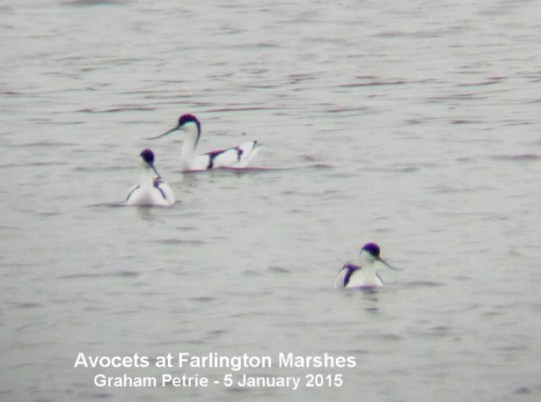
A species count of 43
today, but some really good numbers. Unfortunately, no
Spoonbill or Bewick's Swans, both of which have been
reported recently. Graham did manage to see a group of
40 Bewick's in Burpham, West Sussex last
week.
SUNDAY
JANUARY 4 - 2015
Brook
Meadow
Malcolm
Phillips was present on the meadow this morning to
take photos of a special workday which I was not able
to get to. He noted a large group of workers cutting
away the brambles around Goosebury Cottage so that the
bank can be checked for leaks. This was a joint
community effort by the Brook Meadow Conservation
Group and Lumley residents along with volunteers from
the company Opus who are the firm involved in the
Flood action initiative in the Lumley area. The aim is
to see how Gooseberry Cottage which was flooded twice
in last winter's floods can be better protected.
Today's objective was to examine the bund which
surrounds the cottage on the Meadow side by making one
meter wide clearance strips through the brambles at 10
meter intervals.
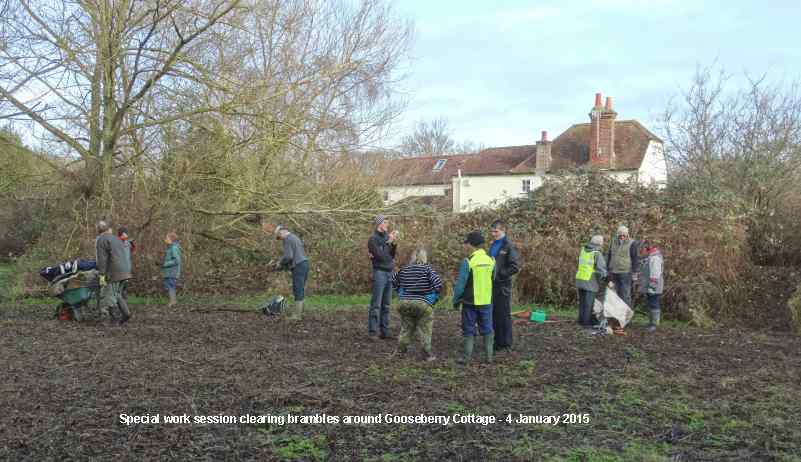
While he was on the
meadow Malcolm got a photo of a very fine Song Thrush
thrusting out its well marked chest.
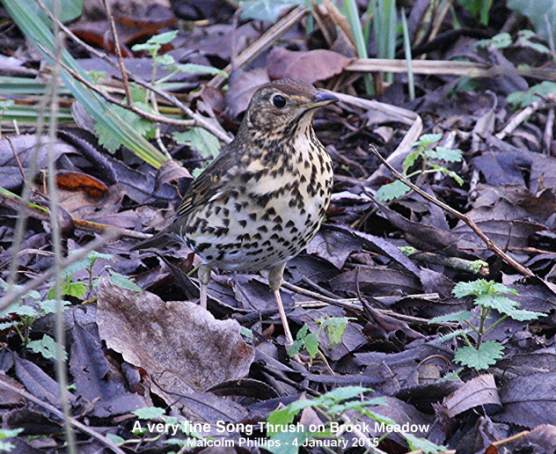
Langstone
shore
Peter
Milinets-Raby was out this morning before sunrise to
check out the shore beside Langstone Mill Pond (7:52am
to 9:50am - tide slowly pushing in to high tide at
10:30am - grey overcast morning with no wind, so
perfect for birding. The highlights were as
follows:
Langstone Mill Pond: Male and female Wigeon. Male
present at first light, but later when I walked
passed, the female was on her own. 2 Grey Heron
roosting when the tide pushed in. Stock Dove.
Flooded horse paddock: An impressive count of 92 Teal.
13 Moorhen.
Stream outflow by old mill: Kingfisher sat on one of
the seaweed covered posts. Little Egret. Greenshank
(usual colour ring bird - G//R+BRtag//-).
Off shore (towards Wade Lane footpath entrance): 483
Brent Geese. 870+ Dunlin (70% of them surprisingly
departed early towards Langstone Harbour when there
were still huge areas of mud exposed). In the
remaining small flock of Dunlin, the winter plumage
Curlew Sandpiper was picked up and for twenty minutes
gave good views before flying off on its own across
the channel before turning towards Langstone
Harbour/Oysterbeds direction.
76 Shelduck. 2 Greenshank, eventually departed towards
Thorney to roost. 1 Avocet (spent the entire time fast
asleep - see photo. It then flew across to the
"island" in the middle of the channel where it went
back to sleep).
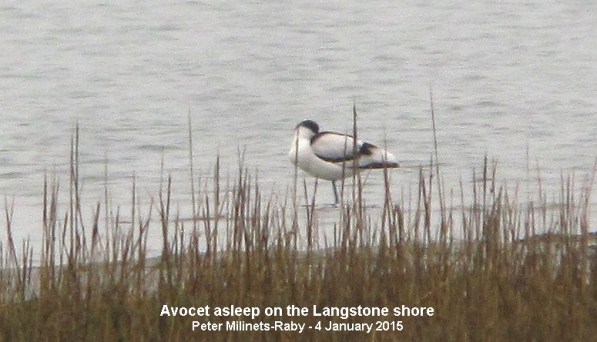
48 Golden Plover on
the salt marsh and a flock of 140+ over north Hayling
shore. 8 Knot. 3 Black-tailed Godwit. 55 Lapwing. 1
Turnstone (so unusual here). 22 Wigeon. 100+
Bar-tailed Godwit flock transferring from a submerging
sandbar to the "island" to roost. A female Goosander
seen briefly in flight heading west down the channel.
17 Red Breasted Merganser (8 males busy
displaying).
SATURDAY
JANUARY 3 - 2015
Brook
Meadow
Malcolm
Phillips tried to find you something different in the
wind and rain this morning and he successed. He saw
the regular Siberian Chiffchaff on the wood chips
again, but this is getting to be rather old hat by
now. If you have not caught up with it look out for it
on the pile of wood chippings just south of the
S-bend. This seems to be its favourite place now.
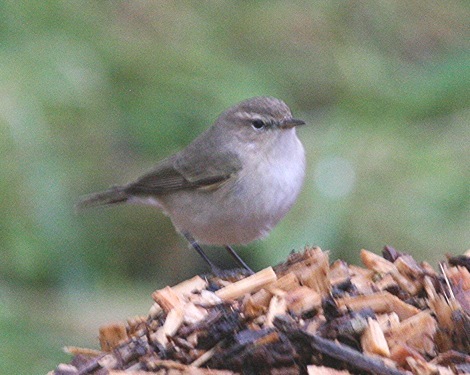
Malcolm's most
interesting sighting of the morning was a small vole
that he photographed in the vegetation opposite the
deep water sign in Palmer's Road Copse. In view of the
time of the year, I don't think it could be a young
Water Vole. Its chubby appearance suggests either Bank
Vole or Field Vole. My hunch is Bank Vole from its
brownish colouring, though I have just shown them to
my two granddaughters and they thought it looked more
like a Field Vole when compared with the pictures in
the Reader's Digest Guide to Animals of Britain!
Anyway, here are Malcolm's two photos of the same
animal if anyone else can throw some light on the
ID.
Ralph Hollins's vote is for Bank Vole which he says is
usually a brighter brown colour where the Field Vole
is usually Greyer. Additionally, the Wildabout Britain
character who calls himself Dogghound says that the
ears of the Bank Vole stick out where those of the
Field Vole are usually hidden in its fur - see
http://www.wildaboutbritain.co.uk/forums/mammal-forums/93917-difference-between-field-voles-and-bank-voles.html
PS I myself am still
out of action on the wildlife watching front, apart
from garden watching and the occasional excursion to
the millpond. This is partly due to my ongoing chest
infection and partly due to the fact that Jean and I
have been looking after two of our granddaughters for
the past 4 days (6 and 8 years).
FRIDAY
JANUARY 2 - 2015
Siberian
Chiffchaff
After about
six hours of creeping around Brook Meadow today, Mike
Wells finally spotted the Siberian Chiffchaff on the
pile of wood chippings opposite where the trees have
been cut down below the S-bend. Perseverance certainly
pays off. Mike sent me two photos of the same bird,
one taken in the shade and the other in bright
sunlight. Good to compare plumages in different
lights.
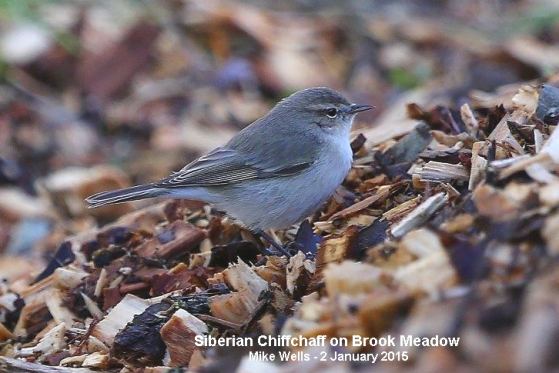
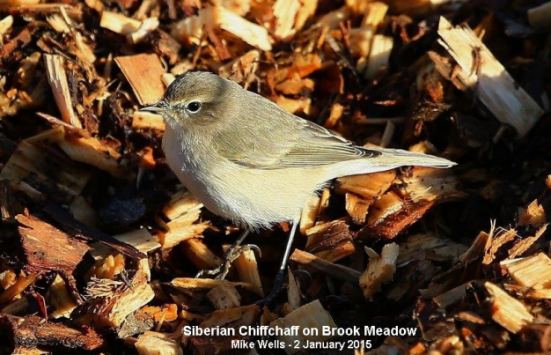
Malcolm Phillips also
captured the Siberian Chiffchaff on the pile of wood
chippings - that is clearly a good habitat to look out
for it. Malcolm also included a photo of a common
Chiffchaff for comparison. The Siberian Chiffchaff has
now been on Brook Meadow for at least 3 weeks. Our
first sighting was on Dec 11.
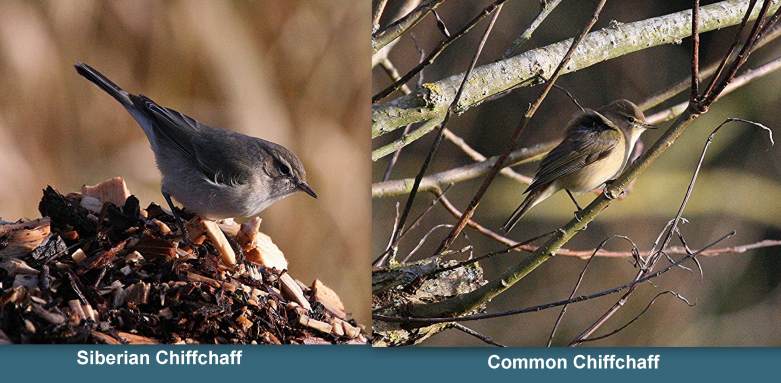
Kingfishers
Malcolm
Phillips had a great day for Kingfishers mostly around
Peter Pond and Slipper Millpond. Here is a nice image
that Malcolm got on a female sitting on the wall of
the Lord Raglan pub overlooking Dolphin Lake.
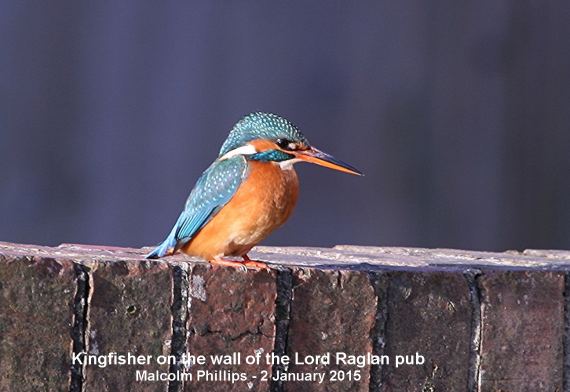
Malcolm also got some
dramatic photos of a Kingfisher (also female and
probably the same bird) diving from the table at the
north of Peter Pond and catching a fish and brining it
back to the table.
From there Malcolm
went over to the south bridge on Brook Meadow from
where he stood with Brian Lawrence and watched another
Kingfisher dive in and out of the river at least 20
times, amazing. This is clearly becoming the
Kingfisher winter.
THURSDAY
JANUARY 1 - 2015
Brook
Meadow
Malcolm
Phillips says that with a cold coming he has had to
join me on the hot lemon, honey and brandy brigade.
However, he is a tough fellow and was determined to
get out in the fresh air this morning. He went round
Brook Meadow as usual and was rewarded with a couple
of cracking birds with his trusty camera. First was a
Goldcrest just south of the north bridge
showing its golden crest to very good effect.
Interestingly, Peter Milinets-Raby recorded three
Goldcrests on the meadow during his New Year's Day
birdwatch this morning - see below.
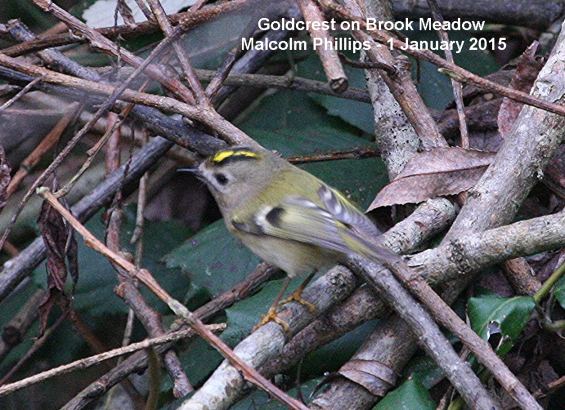
Next, in Palmer's Road
Copse, he got a very grey looking Chiffchaff, which
could well be the Siberian Chiffchaff that
Malcolm has seen on many occasions in this location.
The Siberian Chiffchaff was our star bird of last
year, and looks likely to be our star bird of this new
year as well.
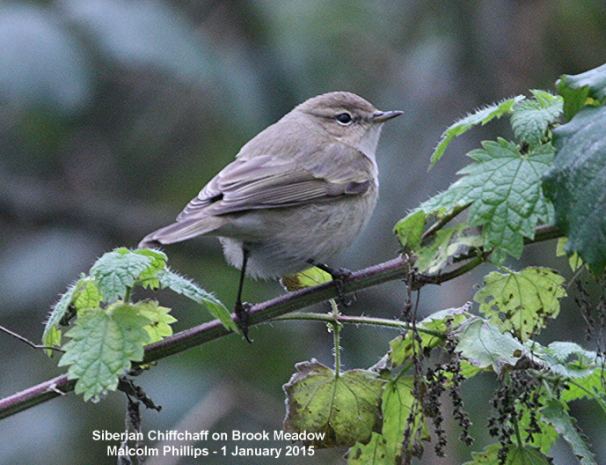
Peter's
New Year's Day List
Peter
Milinets-Raby was out early and despite the very windy
conditions (and a little bit of drizzle at times)
persevered with his usual Jan 1st Day List (7:30am to
1:20pm).
Armed with lots of local knowledge he reached a very
good total of 76 species for the day. If only the
weather was a little better and he thought he could
have clocked a few more! The highlights were as
follows:
Bidbury Mead: Grey Wagtail, Kingfisher, Green
Woodpecker, Great Spotted Woodpecker, Linnet,
Sparrowhawk.
Hermitage Stream (Barncroft Road): Green Sandpiper, 2
Grey Wagtails.
Leigh Park shopping centre: Lesser Black-backed
Gull.
Brook Meadow: Chiffchaff, 3 Goldcrest.
Nore Barn (Just as the tide was dropping): 2 Spotted
Redshank in the stream with 5 Black-tailed Godwits,
40+ Wigeon and 80+ Teal. 1 male 2 female Pintail.
Off Beacon Square: 40+ Knot, 1 Ringed Plover.
Emsworth Mill Pond Sea Wall: 1 Greenshank
(G//R+BNtag//-), Red Breasted Merganser male on pond,
1 Turnstone, 13 Gadwall, 6 Little Grebes, Another 40+
Knot, Great Black-backed Gull.
Warblington (Off Pook Lane): 1 Avocet (first I
have seen here and undoubtedly the bird of the day), 1
Curlew Sandpiper in with 350+ Dunlin, 4 Pintail, 72
Shelduck, 2 Stock Dove, Female Goldeneye, Female
Bullfinch along the lane.
Budds Farm: 12+ Shoveler, 22+ Tufted Duck, 3 male
Pochard, Water Rail (heard), Reed Bunting
(heard).
For
earlier observations go to . . . December
16-31 - 2014